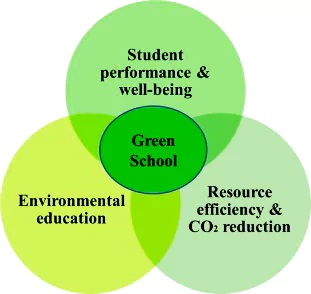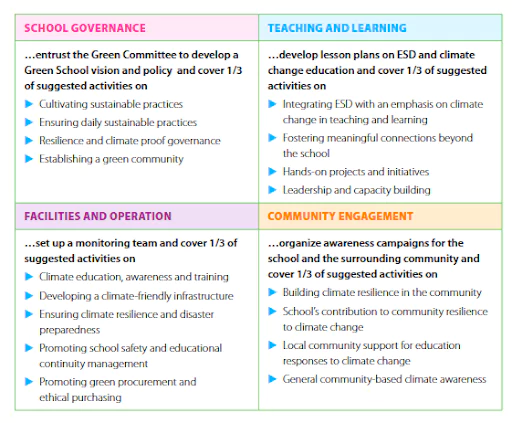The Green School Quality Standard, in collaboration with the Greening Education Partnership, creates a unified approach for stakeholders to work together towards a global goal.

Global Green School Initiative, Unifying Stakeholders for Sustainable Education
This goal aims to ensure that at least 50% of schools worldwide adopt sustainable practices by 2030.
- Unified Approach: The standard and partnership provide a common language for all stakeholders involved in education to work collectively towards greening schools.
About Green School
Green School is a learning institution that integrates Education for Sustainable Development (ESD).
- It focuses on climate change as a central theme.
Enroll now for UPSC Online Course
Green School concept in india
- In India, identification and recognition of this school is done by Green School Programme
- It is an initiative by the Centre for Science and Environment (CSE).
- Objective: The main aim of this concept is to foster environmental awareness among students through hands-on activities.
- For example: Secmol (Students’ Educational and Cultural Movement of Ladakh)
- It is located in pre – himalayan mountains along the Indus River in Ladakh.
|
- This school prepares learners and communities to address climate change impacts through sustainable practices.
- The term “school” encompasses all types of learning institutions, including formal and non-formal environments.
Objectives
- Climate Readiness: Green Schools aim to become safe and resilient learning spaces while fostering innovation to equip learners and communities with the knowledge, skills, values, and attitudes needed to tackle climate change.
- Agents of Change: They promote global citizenship, community action, and sustainable culture by incorporating ESD into the curriculum.
Check Out UPSC Modules From PW Store
The Green School Quality Standard
It is a framework to make schools more sustainable. It helps schools integrate sustainability and climate action into their everyday activities.
Objectives
- Integration of Sustainability: The standard aims to include sustainability and climate action in school operations, teaching, and community interactions.
- Holistic Education: It ensures a complete education journey from early years to higher education with a focus on sustainability.
- Lifelong Learning Perspective: The standard promotes sustainability values from an early age and throughout life.

Key Components
- Early Years Education: Teaching sustainability concepts early to build a foundation for future behaviors.
- Higher Education Integration: Ensuring sustainability is part of advanced learning and professional settings.
- Lifelong and Life-wide Education: Recognizing learning happens beyond classrooms, promoting sustainability in various life contexts.
Check Out Previous Years Papers From PW Store
Initiatives to Support Schools by the government
Governments can take various steps to assist schools in their transition to becoming green climate-ready schools:
- Information and Training Sessions: Offer workshops and training sessions for school leaders and teachers.
- These sessions ensure they understand the country’s policy frameworks and available support for schools.
- Partnerships and Networking: Create opportunities for schools to form partnerships and networks with stakeholders.
- This collaboration enhances support and sharing of resources among schools.
- Connections with Relevant Sectors: Facilitate connections between schools and other sectors such as disaster risk management, environmental conservation, health, and nutrition.
- Additionally, connect schools with the scientific community to promote collaboration in greening efforts.
Enroll now for UPSC Online Classes
![]() 10 Jun 2024
10 Jun 2024


